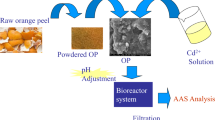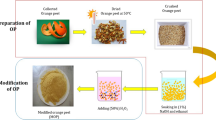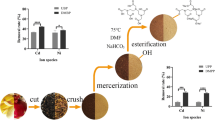Abstract
The treatment of heavy metal (HM) wastewater is a critical and considerable challenge. Fruit peel-based HM adsorption is a promising way for the water pollution control and the reuse of agricultural waste. In this study, a novel adsorbent based on orange peel was synthesized for the first time by introducing abundant -COO groups with ethylenediaminetetraacetic dianhydride (EDTAD) to eliminate Cd(II) and Co(II) of sewage solution. The synthesized adsorbent displayed excellent adsorption capacity of 51.020 and 40.486 mg/g for Cd(II) and Co(II), respectively, and the adsorption equilibrium was achieved within 5 min, following the Langmuir isotherm model and the pseudo-second-order model. Surface characterization of adsorbents by scanning electron microscopy-energy dispersive X-ray spectroscopy, Fourier transform infrared spectroscopy, and X-ray photoelectron spectroscopy confirmed that ion exchange, complexation, and physical adsorption could occur during the adsorption process. The rapid and highly efficient adsorption performance suggests EDTAD-modified synthesized orange peel possesses great potential for HM removal from sewage systems.







Similar content being viewed by others
Availability of data and materials
The datasets used and/or analyzed during the current study are available from the corresponding author on reasonable request.
References
Anju M, Banerjee DK (2011) Multivariate statistical analysis of heavy metals in soils of a Pb–Zn mining area. Environmental Monitoring and Assessment, India. https://doi.org/10.1007/s10661-011-2255-8
Annadurai G, Juang RS, Lee DJ (2003) Adsorption of heavy metals from water using banana and orange peels. Water Sci Technol. https://doi.org/10.1016/S0043-1354(02)00272-5
Antuna-Nieto C, Rodriguez E, Lopez-Anton MA, Garcia R, Martinez-Tarazona MR (2020) Noble metal-based sorbents: a way to avoid new waste after mercury removal. J Hazard Mater. https://doi.org/10.1016/j.jhazmat.2020.123168
Ayoubi S, Karami M (2019) Pedotransfer functions for predicting heavy metals in natural soils using magnetic measures and soil properties. J Geochem Explor. https://doi.org/10.1016/j.gexplo.2018.12.006
Bagheri N, Mansour Lakouraj M, Hasantabar V, Mohseni M (2021) Biodegradable macro-porous CMC-polyaniline hydrogel: synthesis, characterization and study of microbial elimination and sorption capacity of dyes from waste water. J Hazard Mater. https://doi.org/10.1016/j.jhazmat.2020.123631
Behjati M, Baghdadi M, Karbassi A (2018) Removal of mercury from contaminated saline wasters using dithiocarbamate functionalized-magnetic nanocomposite. J Environ Manage. https://doi.org/10.1016/j.jenvman.2018.02.052
Brohi ROZ, Khuhawar MY, Mahar RB, Ibrahim MA (2021) Novel bimetallic nano particles for sorption of mercury (II) from drinking water: adsorption experiment and computational studies. Journal of Water Process Engineering. https://doi.org/10.1016/j.jwpe.2020.101727
Bulin C, Zhang Y, Li B, Zhang B (2020) Removal performance of aqueous Co(II) by magnetic graphene oxide and adsorption mechanism. J Phys Chem Solids. https://doi.org/10.1016/j.jpcs.2020.109483
Cabooter D, Song H, Makey D, Sadriaj D, Dittmann M, Stoll D, Desmet G (2021) Measurement and modelling of the intra-particle diffusion and b-term in reversed-phase liquid chromatography. J Chromatogr A. https://doi.org/10.1016/j.chroma.2020.461852
Chen X, Chen W, Mulchandani A, Mohideen U (2012) Application of displacement principle for detecting heavy metal ions and EDTA using microcantilevers. Sens Actuators, B Chem. https://doi.org/10.1016/j.snb.2011.10.020
Chen Y, Li M, Li Y, Liu Y, Chen Y, Li H, Li L, Xu F, Jiang H, Chen L (2021) Hydroxyapatite modified sludge-based biochar for the adsorption of Cu2+ and Cd2+: adsorption behavior and mechanisms. Biores Technol. https://doi.org/10.1016/j.biortech.2020.124413
Ding C, Cheng W, Wang X, Wu ZY, Sun Y, Chen C, Wang X, Yu SH (2016) Competitive sorption of Pb(II), Cu(II) and Ni(II) on carbonaceous nanofibers: a spectroscopic and modeling approach. J Hazard Mater. https://doi.org/10.1016/j.jhazmat.2016.04.002
Ding C, Cheng W, Wang X, Wu Z-Y, Sun Y, Chen C, Wang X, Yu S-H (2020) Corrigendum: competitive sorption of Pb(II), Cu(II) and Ni(II) on carbonaceous nanofibers: a spectroscopic and modeling approach. J Hazard Mater. https://doi.org/10.1016/j.jhazmat.2020.122118
Elkady M, Shokry H, Hamad H (2020) New activated carbon from mine coal for adsorption of dye in simulated water or multiple heavy metals in real wastewater. Materials. https://doi.org/10.3390/ma13112498
Fang X, Li J, Li X, Pan S, Zhang X, Sun X, Shen J, Han W, Wang L (2017) Internal pore decoration with polydopamine nanoparticle on polymeric ultrafiltration membrane for enhanced heavy metal removal. Chem Eng J. https://doi.org/10.1016/j.cej.2016.12.125
Feng N, Guo X, Liang S, Zhu Y, Liu J (2011) Biosorption of heavy metals from aqueous solutions by chemically modified orange peel. J Hazard Mater. https://doi.org/10.1016/j.jhazmat.2010.08.114
Gao LY, Deng JH, Huang GF, Li K, Cai KZ, Liu Y, Huang F (2019) Relative distribution of Cd2+ adsorption mechanisms on biochars derived from rice straw and sewage sludge. Biores Technol. https://doi.org/10.1016/j.biortech.2018.09.138
Gu YG, Li QS, Fang JH, He BY, Fu HB, Tong ZJ (2014) Identification of heavy metal sources in the reclaimed farmland soils of the pearl river estuary in China using a multivariate geostatistical approach. Ecotoxicol Environ Saf. https://doi.org/10.1016/j.ecoenv.2014.04.003
Gupta M, Gupta H, Kharat DS (2018) Adsorption of Cu(II) by low cost adsorbents and the cost analysis. Environ Technol Innov. https://doi.org/10.1016/j.eti.2018.02.003
Huang Z, Cheng C, Liu Z, Luo W, Zhong H, He G, Liang C, Li L, Deng L, Fu W (2019) Gemini surfactant: a novel flotation collector for harvesting of microalgae by froth flotation. Biores Technol. https://doi.org/10.1016/j.biortech.2018.12.106
Jia X, Fu T, Hu B, Shi Z, Zhu Y (2020) Identification of the potential risk areas for soil heavy metal pollution based on the source-sink theory. J Hazard Mater. https://doi.org/10.1016/j.jhazmat.2020.122424
Jin Y, Teng C, Yu S, Song T, Dong L, Liang J, Bai X, Liu X, Hu X, Qu J (2018) Batch and fixed-bed biosorption of Cd(II) from aqueous solution using immobilized Pleurotus ostreatus spent substrate. Chemosphere. https://doi.org/10.1016/j.chemosphere.2017.08.154
Jin Z, Deng S, Wen Y, Jin Y, Pan L, Zhang Y, Black T, Jones KC, Zhang H, Zhang D (2019) Application of Simplicillium chinense for Cd and Pb biosorption and enhancing heavy metal phytoremediation of soils. Sci Total Environ. https://doi.org/10.1016/j.scitotenv.2019.134148
Júnior OK, Gurgel LVA, de Freitas RP, Gil LF (2009) Adsorption of Cu(II), Cd(II), and Pb(II) from aqueous single metal solutions by mercerized cellulose and mercerized sugarcane bagasse chemically modified with EDTA dianhydride (EDTAD). Carbohyd Polym. https://doi.org/10.1016/j.carbpol.2009.02.016
Jurado-Sánchez B, Sattayasamitsathit S, Gao W, Santos L, Fedorak Y, Singh VV, Orozco J, Galarnyk M (2015) Self-propelled activated carbon Janus micromotors for efficient water purification. Small. https://doi.org/10.1002/smll.201402215
Kai C, Wei W, Biying R, Jing He (2017) A phytic acid modified CoFe2O4 magnetic adsorbent with controllable morphology, excellent selective adsorption for dyes and ultra-strong adsorption ability for metal ions. Chem Eng J. https://doi.org/10.1016/j.cej.2017.08.009
Kerr JG, Cooke CA (2017) Erosion of the Alberta badlands produces highly variable and elevated heavy metal concentrations in the Red Deer River, Alberta. Science of The Total Environment. https://doi.org/10.1016/j.scitotenv.2017.04.037
Kołodyńska D, Hubicka H, Hubicki Z (2008) Sorption of heavy metal ions from aqueous solutions in the presence of EDTA on monodisperse anion exchangers. Desalination. https://doi.org/10.1016/j.desal.2007.06.022
Kołodyńska D, Krukowska J, Thomas P (2017) Comparison of sorption and desorption studies of heavy metal ions from biochar and commercial active carbon. Chem Eng J. https://doi.org/10.1016/j.cej.2016.08.088
Krylova V, Dukštienė N (2019) The structure of PA-Se-S-Cd composite materials probed with FTIR spectroscopy. Appl Surf Sci. https://doi.org/10.1016/j.apsusc.2018.11.121
Lasheen MR, Ammar NS, Ibrahim HS (2012) Adsorption/desorption of Cd(II), Cu(II) and Pb(II) using chemically modified orange peel: equilibrium and kinetic studies. Solid State Sci. https://doi.org/10.1016/j.solidstatesciences.2011.11.029
Lessa EF, Gularte MS, Garcia ES, Fajardo AR (2017) Orange waste: a valuable carbohydrate source for the development of beads with enhanced adsorption properties for cationic dyes. Carbohyd Polym. https://doi.org/10.1016/j.carbpol.2016.10.019
Li X, Tang Y, Cao X, Lu D, Luo F, Shao W (2008) Preparation and evaluation of orange peel cellulose adsorbents for effective removal of cadmium, zinc, cobalt and nickel. Colloids Surf, A. https://doi.org/10.1016/j.colsurfa.2007.11.031
Li Z, Ge Y (2018) Application of lignin and its derivatives in adsorption of heavy metal ions in water: a review. ACS Sustainable Chemistry & Engineering. https://doi.org/10.1021/acssuschemeng.8b01345
Lim SF, Zheng YM, Zou SW, Chen JP (2008) Characterization of copper adsorption onto an alginate encapsulated magnetic sorbent by a combined FT-IR, XPS and mathematical modeling study. Environmental Science and Technology. https://doi.org/10.1021/es7021889
Ling C, Liu FQ, Xu C, Chen TP, Li AM (2013) An integrative technique based on synergistic coremoval and sequential recovery of copper and tetracycline with dual-functional chelating resin: roles of amine and carboxyl groups. ACS Appl Mater Interfaces. https://doi.org/10.1021/am403491b
Liu C, Huu Hao N, Guo W, Tung K-L (2012) Optimal conditions for preparation of banana peels, sugarcane bagasse and watermelon rind in removing copper from water. Biores Technol. https://doi.org/10.1016/j.biortech.2012.06.004
Ma L, Wang L, Tang J, Yang Z (2017) Arsenic speciation and heavy metal distribution in polished rice grown in Guangdong Province, Southern China. Food Chemistry. https://doi.org/10.1016/j.foodchem.2017.04.097
Mei Y, Xu J, Zhang Y, Li B, Fan S, Xu H (2021) Effect of Fe-N modification on the properties of biochars and their adsorption behavior on tetracycline removal from aqueous solution. Biores Technol. https://doi.org/10.1016/j.biortech.2021.124732
Memon JR, Memon SQ, Bhanger MI, Memon GZ, El-Turki A, Allen GC (2008) Characterization of banana peel by scanning electron microscopy and FT-IR spectroscopy and its use for cadmium removal. Colloid Surf. B-Biointerfaces. https://doi.org/10.1016/j.colsurfb.2008.07.001
Mia S, Dijkstra FA, Singh B (2017) Aging induced changes in biochar’s functionality and adsorption behavior for phosphate and ammonium. Environ Sci Technol. https://doi.org/10.1021/acs.est.7b00647
Módenes AN, de Abreu Pietrobelli JMT, dos Santos GHF, Borba CE, da Silva Sá Ravagnani MA, Espinoza-Quiñones FR (2018) Multi-component mathematical model based on mass transfer coefficients for prediction of the Zn and Cd ions biosorption data by E. densa in a continuous system. Journal of Environmental Chemical Engineering. https://doi.org/10.1016/j.jece.2018.08.001
Moreno-Pirajan JC, Giraldo L (2012) Heavy metal ions adsorption from wastewater using activated carbon from orange peel. E-Journal of Chemistry. https://doi.org/10.1155/2012/383742
Mourya A, Mazumdar B, Sinha SK (2019) Determination and quantification of heavy metal ion by electrochemical method. J Environ Chem Eng. https://doi.org/10.1016/j.jece.2019.103459
Németh G, Mlinárik L, Török Á (2016) Adsorption and chemical precipitation of lead and zinc from contaminated solutions in porous rocks: possible application in environmental protection. J Afr Earth Sc. https://doi.org/10.1016/j.jafrearsci.2016.04.022
Pathak PD, Mandavgane SA, Kulkarni BD (2015) Fruit peel waste as a novel low-cost bio adsorbent. Rev Chem Eng. https://doi.org/10.1515/revce-2014-0041
Pereira FV, Gurgel LVA (2010) Removal of Zn2+ from aqueous single metal solutions and electroplating wastewater with wood sawdust and sugarcane bagasse modified with EDTA dianhydride (EDTAD). J Hazard Mater. https://doi.org/10.1016/j.jhazmat.2009.11.115
Sameena, N.Malik, Shahabaz, M.Khan, Prakash, C.Ghosh, Atul, N.Vaidya, Gajanan (2019) Microscopic morphology and seasonal variation of health effect arising from heavy metals in PM2.5 and PM10: one-year measurement in a densely populated area of urban Beijing. Atmospheric Research. https://doi.org/10.1016/j.atmosres.2018.04.027
Singh SA, Shukla SR (2015) Adsorptive removal of cobalt ions on raw and alkali-treated lemon peels. Int J Environ Sci Technol. https://doi.org/10.1007/s13762-015-0801-6
Surgutskaia NS, Martino AD, Zednik J, Ozaltin K, Lovecká L, Bergerová ED, Kimmer D, Svoboda J, Sedlarik V (2020) Efficient Cu2+, Pb2+ and Ni2+ ion removal from wastewater using electrospun DTPA-modified chitosan/polyethylene oxide nanofibers. Sep Purif Technol. https://doi.org/10.1016/j.seppur.2020.116914
Tan IAW, Chan JC, Hameed BH, Lim LLP (2016) Adsorption behavior of cadmium ions onto phosphoric acid-impregnated microwave-induced mesoporous activated carbon. Journal of Water Process Engineering. https://doi.org/10.1016/j.jwpe.2016.10.007
Vilardi G, Di Palma L, Verdone N (2018) Heavy metals adsorption by banana peels micro-powder: equilibrium modeling by non-linear models. Chin. Chemical Engineering Journal. https://doi.org/10.1016/j.cjche.2017.06.026
Villen-Guzman M, Cerrillo-Gonzalez MM, Paz-Garcia JM, Rodriguez-Maroto JM, Arhoun B (2021) Valorization of lemon peel waste as biosorbent for the simultaneous removal of nickel and cadmium from industrial effluents. Environ Technol Innov. https://doi.org/10.1016/j.eti.2021.101380
Wang X, Chen QR, Lu X (2014) Pectin extracted from apple pomace and citrus peel by subcritical water. Food Hydrocolloids. https://doi.org/10.1016/j.foodhyd.2013.12.003
Xu H, Hu X, Chen Y, Li Y, Zhang R, Tang C, Hu X (2021) Cd(II) and Pb(II) absorbed on humic acid-iron-pillared bentonite: kinetics, thermodynamics and mechanism of adsorption. Colloids Surf A : Physicochemical and Engineering Aspects. https://doi.org/10.1016/j.colsurfa.2020.126005
Yang GX, Jiang H (2014) Amino modification of biochar for enhanced adsorption of copper ions from synthetic wastewater. Water Res. https://doi.org/10.1016/j.watres.2013.09.050
Yong YA, Xue YA, B MH (2020) Beyond mere pollution source identification: Determination of land covers emitting soil heavy metals by combining PCA/APCS, GeoDetector and GIS analysis. CATENA. https://doi.org/10.1016/j.catena.2019.104297
Yuan G, Tian Y, Liu J, Tu H, Liao J, Yang J, Yang Y, Wang D, Liu N (2017) Schiff base anchored on metal-organic framework for Co (II) removal from aqueous solution. Chem Eng J. https://doi.org/10.1016/j.cej.2017.06.024
Zhang J, Xu Y, Wu Y, Hu S, Zhang Y (2019a) Dynamic characteristics of heavy metal accumulation in the farmland soil over Xiaoqinling gold-mining region, Shaanxi, China. Environmental Earth Sciences. https://doi.org/10.1007/s12665-018-8013-2
Zhang W, Deng Q, He Q, Song J, Zhang S, Wang H, Zhou J, Zhang H (2018) A facile synthesis of core-shell/bead-like poly (vinyl alcohol)/alginate@PAM with good adsorption capacity, high adaptability and stability towards Cu(II) removal. Chem Eng J. https://doi.org/10.1016/j.cej.2018.06.129
Zhang W, Lan Y, Ma M, Chai S, Zuo Q, Kim K-H, Gao Y (2020a) A novel chitosan–vanadium-titanium-magnetite composite as a superior adsorbent for organic dyes in wastewater. Environ Int. https://doi.org/10.1016/j.envint.2020.105798
Zhang W, Song J, He Q, Wang H, Lyu W, Feng H, Xiong W, Guo W, Wu J, Chen L (2020b) Novel pectin based composite hydrogel derived from grapefruit peel for enhanced Cu(II) removal. J Hazard Mater. https://doi.org/10.1016/j.jhazmat.2019.121445
Zhang XH, Zhang ZC, Deng ZH, Li S, Wu QP, Kang ZX (2019b) Precision grinding of silicon nitride ceramic with laser macro-structured diamond wheels. Opt Laser Technol. https://doi.org/10.1016/j.optlastec.2018.08.021
Zhao FP, Repo E, Yin DL, Sillanpaa MET (2013) Adsorption of Cd(II) and Pb(II) by a novel EGTA-modified chitosan material: kinetics and isotherms. J Colloid Interface Sci. https://doi.org/10.1016/j.jcis.2013.07.062
Zheng X, Zhou Y, Liu X, Fu X, Peng H, Lv S (2020) Enhanced adsorption capacity of MgO/N-doped active carbon derived from sugarcane bagasse. Biores Technol. https://doi.org/10.1016/j.biortech.2019.122413
Zhou G, Luo J, Liu C, Chu L, Crittenden J (2018) Efficient heavy metal removal from industrial melting effluent using fixed-bed process based on porous hydrogel adsorbents. Water Res. https://doi.org/10.1016/j.watres.2017.12.067
Zhu YH, Hu J, Wang JL (2012) Competitive adsorption of Pb(II), Cu(II) and Zn(II) onto xanthate-modified magnetic chitosan. Journal of Hazardous Materials. https://doi.org/10.1016/j.jhazmat.2012.04.026
Acknowledgements
We gratefully acknowledge the technical supports from Instrument & Testing Center of Tianjin University of Science and Technology.
Funding
This work was supported by the National Natural Science Foundation of China (Grants 31800072, 31970084, 31400081) and the Open Fund of the Ministry of Education Key Laboratory of Molecular Microbiology and Technology, Nankai University.
Author information
Authors and Affiliations
Contributions
Fanghui Wang, conceptualization, investigation, data curation, and writing—original draft. Peng Wu, investigation, methodology, and writing—original draft. Lin Shu, investigation and review. Di Huang, conceptualization, supervision, and funding acquisition. Huanhuan Liu, conceptualization, supervision, writing—original draft, and funding acquisition.
Corresponding authors
Ethics declarations
Ethics approval and consent to participate
Not applicable.
Consent for publication
Not applicable.
Competing interests
The authors declare no competing interests.
Additional information
Responsible Editor: Tito Roberto Cadaval Jr
Publisher's Note
Springer Nature remains neutral with regard to jurisdictional claims in published maps and institutional affiliations.
Rights and permissions
About this article
Cite this article
Wang, F., Wu, P., Shu, L. et al. High-efficiency adsorption of Cd(II) and Co(II) by ethylenediaminetetraacetic dianhydride-modified orange peel as a novel synthesized adsorbent. Environ Sci Pollut Res 29, 25748–25758 (2022). https://doi.org/10.1007/s11356-021-17501-7
Received:
Accepted:
Published:
Issue Date:
DOI: https://doi.org/10.1007/s11356-021-17501-7




